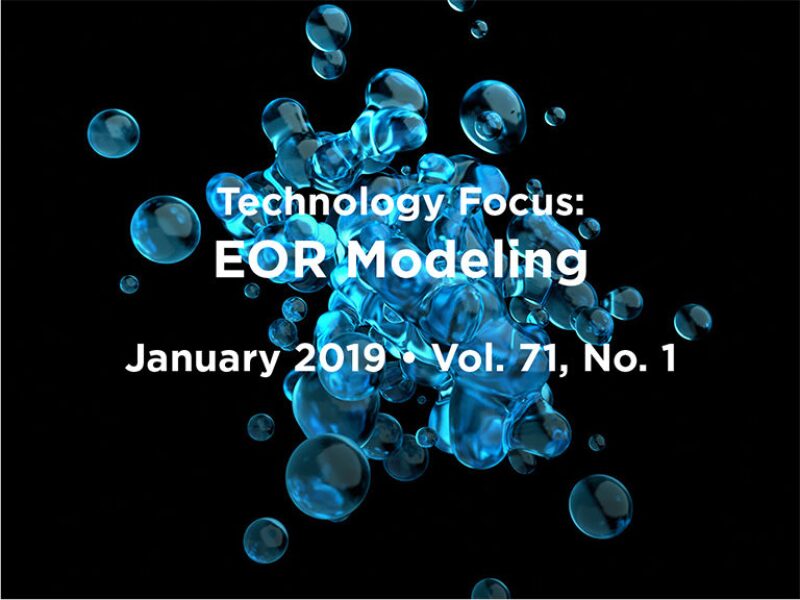As far as I am concerned, 2018 became the year I dealt with some aspect of enhanced oil recovery (EOR) every week. I had noticed that, in recent years, interest in bringing EOR to field operations had been growing everywhere. As operators and asset owners worked continually to increase efficiency in oil production, they all realized that part of efficiency improvement is increasing recovery factors. Everybody now is extremely focused on recovering more from the reservoirs they have. Of course, limited exploration and maturing fields are some of the motives behind that new attitude. Additionally, oil price is at a point now that allows for EOR but is still too low for exploration.
Global interest in implementing EOR had a clearly positive outcome on the quality of the technical papers reviewed this year. All EOR schemes were covered superbly, and discussions were well advanced. Along with new insights for conventional EOR schemes, emerging EOR schemes such as low-salinity waterflooding and EOR for unconventionals were deliberated extensively. Enhancements in understanding how each EOR system works, leading to improvements in EOR modeling and forecasting, certainly will make future EOR projects more successful. We should add the effect of ever-growing cloud computation and the Internet of Things to the anticipated success of new EOR projects. The effect of those enablers is going to benefit EOR projects in every way, from better project design to improved field management. Finally, we are able to construct reservoir models that include all EOR-relevant aspects of the reservoir in all scales. Along with that, the physics for almost all EOR schemes are captured in EOR forecasting models. Practically limitless computer access also will play a significant role in ensuring the success of EOR field management.
Selecting only three papers among so many good ones was a difficult task. The following papers will give you some feeling about the noteworthy advancements happening in EOR performance and modeling. While you are focused on EOR, please consider checking out the other great papers listed as recommended additional reading.
This Month's Technical Papers
Experimental Program Investigates Miscible CO2 WAG Injection in Carbonate Reservoirs
Method Integration Improves Reservoir-Property Prediction in East Siberia
Mechanistic Model Describes Wettability Change in Sandstones and Carbonates
Viability of Gas-Injection EOR in Eagle Ford Shale Reservoirs
Recommended Additional Reading
SPE 189785 A Parametric Study on the Applicability of Miscible-Gases-Based EOR Techniques in Unconventional Liquids-Rich Reservoirs by Dheiaa Alfarge, Iraqi Ministry of Oil, et al.
SPE 190250 Systematically Optimized Surfactant Formulation and Injection Design To Reduce Chemicals While Maintaining Performance by Gayani W.P. Pinnawala Arachchilage, Chevron, et al.
SPE 190305 Diffusion-Dominated Proxy Model for Solvent Injection in Ultratight Oil Reservoirs by M. Cronin, The Pennsylvania State University, et al.
SPE 191474 Application of Artificial Intelligence for Mechanistic Modeling and Probabilistic Forecasting of Hybrid Low-Salinity Chemical Flooding by Cuong Dang, Computer Modelling Group, et al.
SPE 191530 An Equation of State To Model Microemulsion-Phase Behavior in the Presence of Cosolvents Using Average-Solubilization Theory by Soumyadeep Ghosh, Chevron, et al.

| Omer Gurpinar, SPE, is the technical director of enhanced oil recovery for Schlumberger. He leads Schlumberger in development of technologies and services to help improve recovery factors in oil fields. Gurpinar has more than 35 years of industry experience in various aspects of numerical reservoir modeling, with specific focus on naturally fractured reservoirs, reservoir optimization, and EOR. He has contributed to recovery optimization for numerous oil and gas fields globally. Since joining Schlumberger in 1998, Gurpinar has served as the vice president or technical director in various segments. He holds BS and MS degrees in petroleum engineering. Gurpinar is a member of the JPT Editorial Committee and can be reached at ogurpinar@slb.com. |


